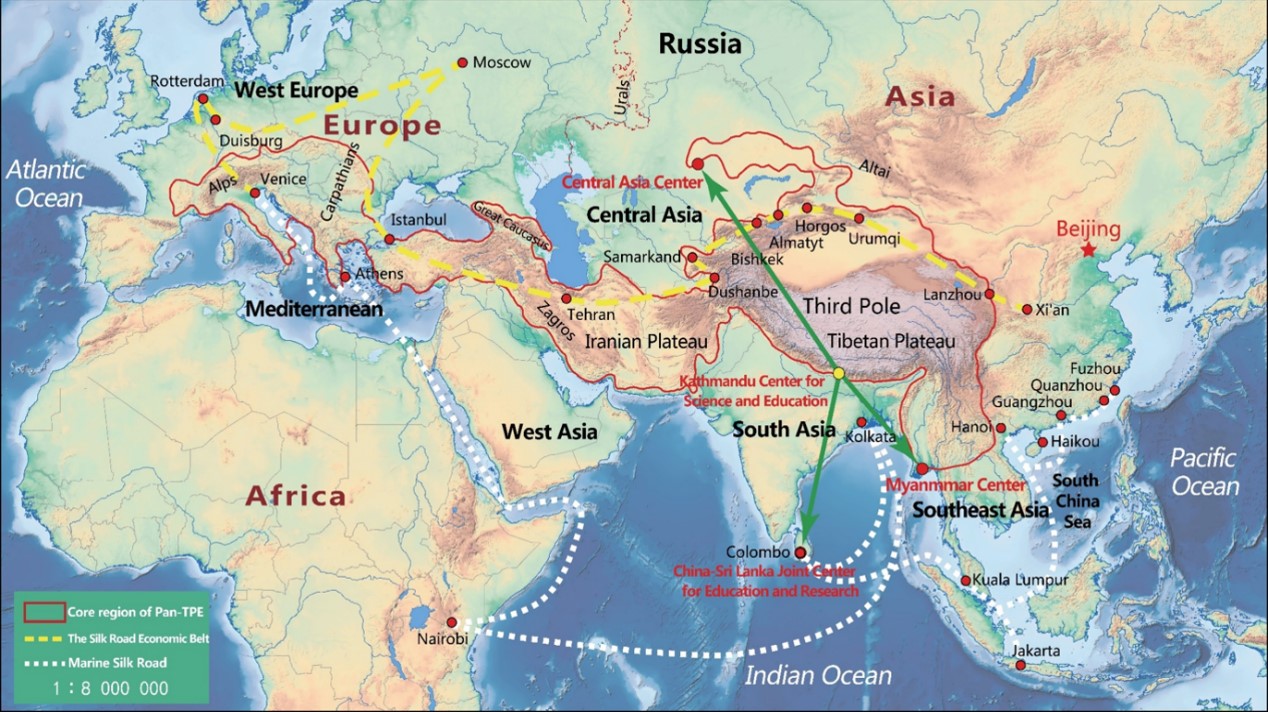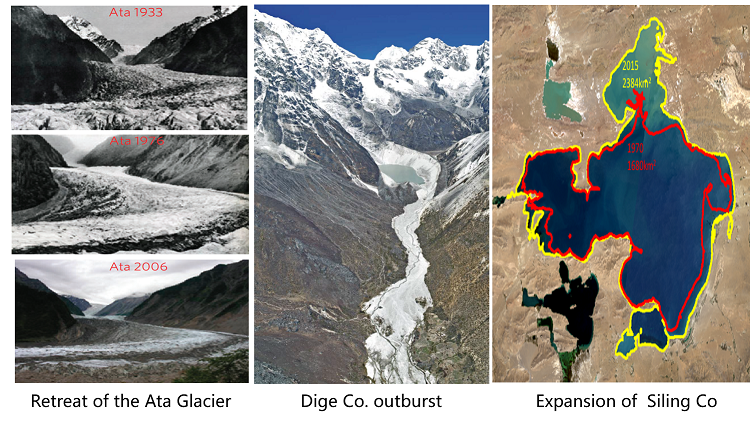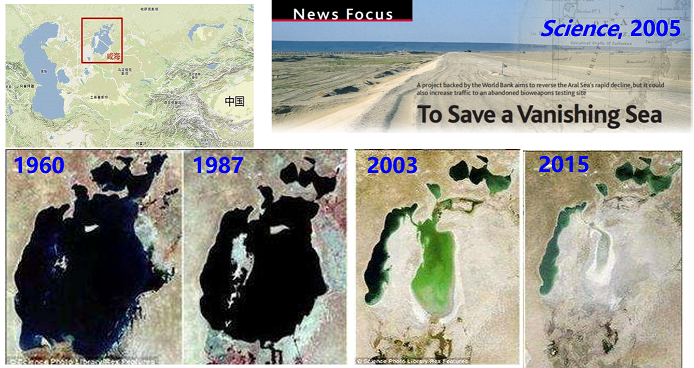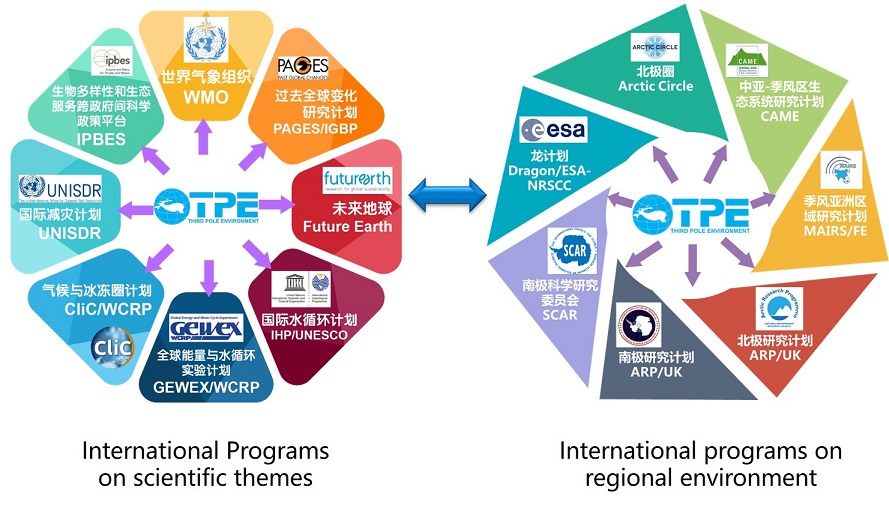About Pan-TPE
Author :admin
2019-02-28 18:08
Extended westward and northward from the Third Pole, the 20-million-km2 Pan-Third Pole encompasses the Eurasian highlands and areas hydrologically affected by them: the Tibetan Plateau, the Pamirs, the Hindu Kush, the Iranian Plateau, the Caucasus, the Carpathians etc. Home to three billion people, the Pan-Third Pole hosts a substantial part of the Silk Road Economic Belt. A deeper understanding of Pan-Third Pole environment changes can generate environmental solutions for high-priority projects in key areas along the route, as part of the efforts to build a green, healthy, intelligent and peaceful Silk Road with science-based policy making.

Known as the Asian Water Tower, the Tibetan Plateau hosts numerous glaciers, lakes and rivers. However, warming-induced glacier retreat, lake expansion and frequent Glacier Lake Outburst Flood (GLOF) are destabilizing the Asian Water Tower, hindering socio-economic development in countries along the routes of the Belt and Road Initiative. The effects of climate change on water resources are most felt at the downstream of the Third Pole, such as the Central Asian great lakes region, where the Aral Sea, the Caspian Sea, the Balkhash Lake, and the Issyk-Kul Lake are located. The Aral Sea, for one, has run dry from overuse since 1960s, its area down from 68,000 km2 to only about 3,000 km2 with its water level being 15m lower. As a result, salination and desertification have ravaged the Aral Sea basin, crippling agriculture and food supply in Central Asia.


To this end, Chinese Academy of Sciences (CAS) launched a Strategic Priority A Program of Pan-Third Pole Environment Study for a Green Silk Road (hereinafter referred to as “Pan-TPE”) in 2018. Anchored in the field of environmental sustainability, the Pan-TPE program is designed to integrate basic science, applied studies, technology innovation and policy-advising. It is the program’s ambition to explain environmental changes across Pan-Third Pole and their implications, to provide solutions to environmental challenges in high-priority projects, and to explore pathways for sustainable development along the Silk Road.
Pan-TPE is structured with two overarching themes: 1) With both nature and human factors at play, what is the role of the Pan Third Pole environmental changes in securing green Silk Road sustainability? 2) The uncertainties of Pan Third Pole environment as influenced by westerly-monsoon interaction
And five major scientific questions: 1) What is the role of westerly-monsoon interaction in water resource change? 2) What are the impacts of climate change on ecosystem and biodiversity and their feedbacks? 3) How to prevent environmental risks and hazards through technology innovation? 4) How to balance human activities and environment resilience? 5) How to tackle environmental challenges facing Silk Road green development?
In light of these, Pan-TPE identifies eight key research topics: 1) Geological and paleo-environmental evolution; 2) Westerly-monsoon interaction and change of Water Tower of Asia and their impacts; 3) Ecosystem and biodiversity change and their response to climate change; 4) Impact and modulation of anthropogenic activities; 5) Environmental risks and mountain hazards; 6) Mitigation and adaptation for environmental resilience based on in-situ observation; 7) Integrated Environmental Assessment for Green Silk Road Development; 8) Far-reaching impacts and feedbacks from Third Pole to Poles.
Pan-TPE also proposes three cross-cutting themes which integrate different aspects of earth system science: 1) Change of Water Tower of Asia and its impacts on Silk Road; 2) Ecosystem change in the coupled human-nature system and social development strategy; and 3) Roadmap towards a Green Silk Road.
Following efforts will be made to fulfil Pan-TPE ambitions: 1) Promoting expedition efforts and long-term observation along climate transects, i.e. the monsoon-dominated transect from Indian Ocean to Central Asia and the westerly-dominated transect from the Atlantic to East China: a grid system of field stations will be set up along these transects to allow for observation of and research on water-soil-air-ecosystem interaction; 2) Facilitating international expedition and research through CAS and TPE overseas networks: CAS has established six Overseas Research and Education Centers in the Pan-Third Pole region, and TPE, the international program initiated in 2009, now also boasts four centers worldwide; Pan-TPE will give full play to these institutions in its global endeavors; 3) working closely with international programs and organizations working on topics of water, ecosystems and environmental changes: many of them are highly relevant to the Pan-Third Pole environment, which the Pan-TPE program will actively collaborate with.



With a focus on water, ecosystem and human activities, the Pan-TPE program studies the mechanism of environmental changes, and looks into the vulnerability, resilience and green development pathways for better environmental and risk management along the Silk Road. Pan-TPE is expected to deliver both scientifically and socially significant results.
The Pan-TPE program is closely intertwined with the Second Tibetan Plateau Scientific Expedition and Research (STEP) endorsed by Chinese President Xi Jinping, who highlighted the importance of ecological progress in Tibetan Plateau in his letter and speech. While advancing scientific frontiers, the Pan-TPE program, together with STEP, will serve as a catalyst to ecological progress in Tibetan Plateau and beyond.
